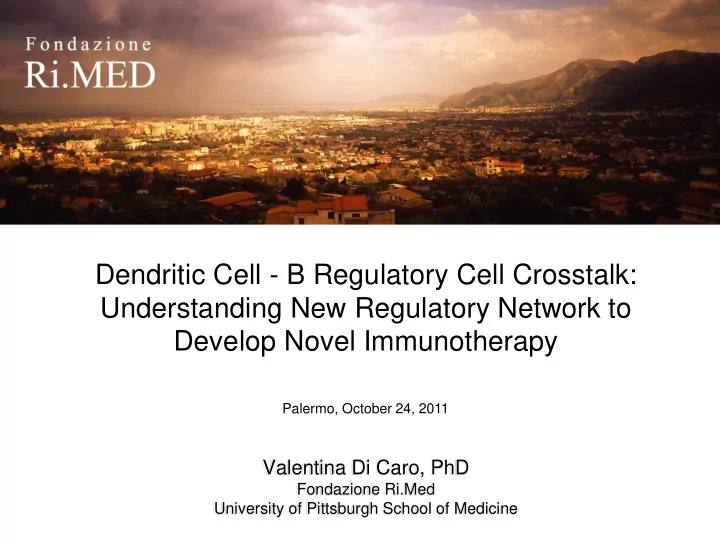

Dendritic Cell - B Regulatory Cell Crosstalk: Understanding New Regulatory Network to Develop Novel Immunotherapy Palermo, October 24, 2011 Valentina Di Caro, PhD Fondazione Ri.Med University of Pittsburgh School of Medicine
Type 1 Diabetes (Mathis D, et al . Nature, 2001)
Reprogramming the immune system to stop the inflammation: Co-stimulation blockade as a strategy to prevent diabetes and to reverse new onset disease
Dendritic Cells Are the body’s Inside the lymph node, sentinels they initiate communication with T-cells (mostly) After sampling the environment, they move to the closest lymph node(s) They sense “tissue states” as Signal can be ACTIVATING or SUPPRESSIVE they migrate throughout the body
Signals between DC and T Cell Tolerogenic dendritic cells can attenuate T cell mediated immune responses by deleting, anergizing or changing the effector function of antigen-specific T cells
Dendritic cell, engineered to maintain low levels of CD40, CD80 and CD86 costimulatory molecules, can prevent type 1 diabetes mellitus and reverse new-onset disease in the non-obese diabetic mouse model (Machen et al . J of Immunology, 2004)
NIH-funded, IRB- and FDA-approved Safety Study To confirm that intradermal administration of autologous diabetes suppressive dendritic cells (DC) is safe, non-toxic and without side-effects . 1. Obtain leukocytes via apheresis 2. Engineer DC towards a “diabetes - suppressive” capacity under GMP/GLP conditions; provide mixture of AS-ODN (CD40/CD80/CD86) 3. Test potency, sterility and divide into individual administration aliquots 4. Administer to volunteer intradermally 5. Immunological, biochemical, physiologic monitoring to establish safety Giannoukakis et al . Ped Diabetes, 2008
B Cells in Phase I Clinical Trial Patients B Cell Changes in Phase I Clinical Trial 70 B220+ CD11c- Cells (%) 60 1 2 50 4 40 6 8 30 9 20 10 12 10 0 1 2 3 4 5 6 7 8 9 10 11 12 13 14 15 16 17 18 Blood Draw (Giannoukakis N et al, Diabetes Care 2011)
(Mizoguchi, A. Journal of Immunology, 2006)
Hypothesis Can AS-ODN DC interact with specific B cell subpopulations, with immune regulatory functions, and promote peripheral tolerance?
Experimental plan Inject Mouse Harvest Spleen CN 3 Days Later Generate Collect DC’s AS-ODN Bone Marrow Overnight Inject Mouse LPS Treatment Perform Flow Cytometry B220 + CD19 + L10 +
Breg cell populations 3 days post DC injection IL10 + Cells CN 36.9 +/- 3.9 • Two populations of IL10 + B220 + CD19 + • 30% increase with AS-ODN AS-ODN DC 47.5 +/- 5.6 treatment • n = 3 mice p = 0.054
B220 + CD19 + IL10 + Bregs isolated from AS-ODN treated mice are suppressive 2 1.8 1.6 * 1.4 1.2 No DC T = T-cells 1 CN DC S = Irradiated AS-ODN DC 0.8 Allo-Spleenocytes ** 0.6 B = 1/10 Mix of B Cells 0.4 *** ** B = 1/1 Mix of B Cells 0.2 0 T S B TS TSB TSB 1:10 1:1 Controls Co-cultures
B220 + CD19 + Bregs suppressive activity is not dependent on IL10 secretion 1.4 1.2 * ** 1 T = CD4 + T-cells 0.8 S = Irradiated Allo-Spleenocytes 0.6 B = 1/10 Mix of B Cells 0.4 IL10 = IL10 Antibody 0.2 0 T S B TS TS+IL-10 TSB TSB+IL-10 antibody antibody
To be suppressive B220 + CD19 + Bregs need to physically interact with T cells Transwell plate T = CD4 + T-cells S = Irradiated Allo-Spleenocytes B = 1/10 Mix of B Cells IL10 = IL10 Antibody
MLR with B220 + CD19 + IL10 + Bregs isolated from buffy coat of human blood **** 1.2 1 T = CD4 + T-cells 0.8 S = stimulators B = 1/10 Mix of B Cells 0.6 0.4 0.2 0 T S B TS TSB
Cytokine production INFgamma Production IL-2 Production 250 120 200 100 150 80 60 100 40 50 20 0 0 1 2 3 1 2 3 TNFalpha Production 100 80 Breg suppression in vitro is associated 60 with impaired production of Th1 type 40 pro-inflammatory cytokines 20 0 1 2 3
Mouse transcriptome analysis 385 up AS-ODN DC 395 down Control DC 200 180 160 n# genes 140 120 Up 100 80 Down 60 40 20 0 1 1.5 2 2.5 3 3.5 4 4.5 5 5.5 6 6.5 7 7.5 8 Fold induction (log)
DC T cell
Human transcriptome analysis 10 8 Fold induction 6 4 P8 2 Up P1 0 1196 Down 0 100 200 300 400 500 600 700 800 153 1296 -2 -4 -6 -8 -10 Control 8 751 6 Fold induction 4 2 0 Up 0 100 200 300 400 500 600 700 Down -2 -4 -6 -8 -10 n# genes
ALDH1A2 expression 1 2 3 4 Fold of induction 1 DC control sample1 2 AS-ODN DC sample1 3 DC control sample 2 4 AS-ODN DC sample2 1 DC control 2 AS-ODN DC
Conclusion Autologous DC can upregulate the frequency of B220 + CD11c - B lymphocytes; This B220 + CD11c - B cell population contain a novel suppressive B regulatory cell subpopulation phenothipically characterized as CD220 + CD19 + IL10 + ; To be suppressive this B regulatory cell needs to physically interact with T cell and DC; Tolerogenic DC produce high level of rate-limiting enzyme for retinoic acid, ALDH1. Still to demonstrate how DC can regulate Breg
Thanks….. Massimo Trucco MD Nick Giannoukakis PhD Brett Phillips PhD Carl Engman Alexis Styche Funding Bob Lakomy NIH Fondazione Ri.Med
Recommend
More recommend